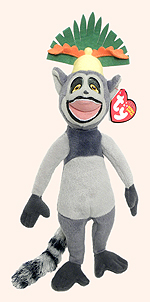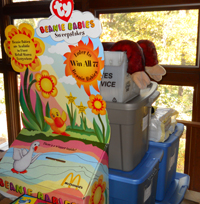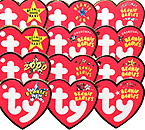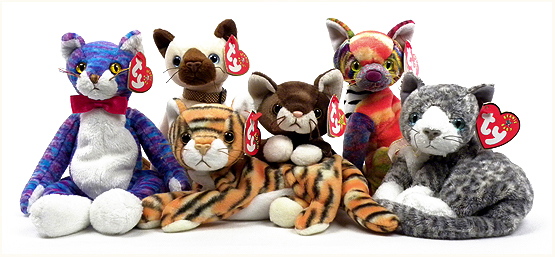Plan in Advance What to Collect
This guidance is for people who want to become serious Ty collectors. If your ultimate goal is to have 15 or 20 Beanie Babies, Boos or other Ty collectibles around the house or office, don't waste your time reading this. Just go to eBay, Amazon or your local Ty retailer and buy a few Beanies, Boos, Teeny Tys or Flippables that appeal to you. If you believe you might make a profit "investing" in beanies, go directly to your toilet and flush a hundred dollar bill. Focus intently on your money as it swirls down the drain. Now flush another hundred dollar bill. This is a learning experience. If you tend to be stubborn, flush a third hundred dollar bill. You just replicated the Beanie investing experience. Now go invest in something more conservative and thank us for saving you thousands of dollars.
For serious, potential collectors, there are important decisions to make before starting a Ty collection. Few people realize just how many Ty products there are. Beanie collecting is fun but it can turn into a frustrating experience if you start spending your money without lots of advance research and a plan.
The first consideration should be the amount of available display space in your home or office. Be honest with yourself. If you don't have enough space to display a collection, what's the point of collecting? Without sufficient space, your collection will end up in cardboard boxes or plastic storage containers in the basement. Five years from now you'll be selling them to reclaim the space for something else. If you believe your stored collection will increase in value over time, go back to the top of this page and follow the instructions in the second half of the first paragraph.
If your available display space is limited, stick to regular-size Beanie Babies, Boos, Ballz, PinkyS and others, or downsize to key-clip sized Beanie Babies, Jingle Beanies, Basket Beanies, Mini Boos and other small-size Ty collectibles like the new Teeny Tys.
You'll need a lot more display space if you plan to collect the larger plush lines like Buddies, Classics and Punkies, or the large sized items from the Ballz, Boos and other Ty product lines. Do the research first, because some of the collectibles are bigger than you might suspect. The Buddies, Punkies and Classics families include many items that are 40 or more inches tall.
Once you have a reasonable idea of your available space, decide WHAT to collect. Ty has produced literally thousands of plush toys comprising several families. You've probably heard of Beanie Babies, Beanie Buddies, Ty Girlz, Teenie Beanie Babies (distributed by McDonalds), Ballz and Boos. But those are only six of the product lines. There are now more than 40 active or retired families (and the number keeps increasing).
One product family has only three beanies (Valenteenies), but most families have 50 or more. The Beanie Baby family itself has more than 3,500 different items if you count variations and oddities.
The goal of many collectors is to acquire ALL of the items in one or more of Ty's product families. With a goal like that, it makes sense to learn how many individual items there are in each family. That takes a little research. Ty collecting can turn quickly into a time consuming and expensive hobby. When I say "expensive," I'm talking well into 6 figures.
Beanie is a slang word commonly applied to any Ty product or even any small stuffed animal regardless of manufacturer. We need to be more specific, so we'll start with Beanie Babies. Lets collect Ty Beanie Babies. All of them? OK. That limits our scope to approximately 3,000+ items for a complete collection. Wait . . . it's more complicated than that. The number could be much higher. Maybe we should start with just one Beanie Baby to illustrate the dilemma.
We'll start with Pinchers. Pinchers is a pretty famous lobster because he's one of the original nine Beanie Babies introduced by Ty in 1993. There is only one Pinchers, right? Well, not really. There is a first generation (gen) Pinchers, a second gen Pinchers, a third, fourth and fifth. The generation is determined by the style of the Ty heart-shaped swing tag attached to the Beanie Baby.
If you have Pinchers without his Ty swing tag, you don't know which generation he is? If you don't care about generations, any one Pinchers will do, maybe.
Beanie Babies don't just have a swing tag, they also have a tush tag; a small rectangular cloth tag normally sewn into a seam on their rear end. The tush tags also come in different generations. There are five possible generations of tush tags for Pinchers. You're probably getting a hint of where this is going, especially when you learn that Pinchers with a fifth generation swing tag doesn't necessarily have a fifth generation tush tag. He could have a fourth generation tush tag.
Maybe it would be easier to collect Beanie Babies by name instead of generation. That way you need only one Pinchers because all of the different generations of Pinchers look pretty much the same. That would save money too, because you can buy a 4th or 5th gen Pinchers for one or two dollars, but a Pinchers with 1st generation swing and tush tags will cost anywhere from $400 to $750 or more, depending on his condition and the condition of his tags.
I almost forgot. We probably need the BBOC Pinchers too. BBOC was the Beanie Babies Official Club. In 2005, club members could purchase replicas of the original 9 Beanie Babies. Pinchers showed up again, this time with a BBOC button stuck to his tail. Well, it is a Beanie Baby and we're collecting them all, right?
Now for a complication. Pinchers started out as Pinchers but escaped from the factory for a short time with the name Punchers on its swing tag. Ty corrected the mistake but an unknown (limited) number of Punchers made it to retail shelves. Mistakes like this are categorized as "oddities" and the existence of various oddities might have a bearing on your decision about WHAT to collect. Over the years, Ty accidentally produced numerous oddities and some people specialize in collecting them. That can be fun and challenging but it is difficult to place a legitimate value on oddities because nobody really knows how many of them were produced. The most common type of oddity is a Beanie Baby with its correct name on the swing tag but an incorrect name on its tush tag.
Maybe we should avoid the oddities for now (nobody knows for sure just how many different oddities exist), purchase a 4th gen Pinchers for two dollars and move on to Tank. Start a savings account for Punchers if you want him. Although many of the well-known tag oddities are available for reasonable prices just a few dollars more than the correct versions, Punchers will cost you a few months worth of groceries for a large family.
Here's another example. Tank showed up in 1996. The original Tank had seven lines sewn into his body to imitate an armadillo's armor plates. Later in 1996, Ty released a new Tank with nine lines sewn in. To confuse the matter further, a second 9-line Tank showed up with a design that made the shell more realistic in appearance. Collectors refer to them as the "9-line with shell" and the "9-line no shell" versions. This makes three distinctly different versions of a Beanie Baby sharing the same name and style number.
Tank also has multiple generations of swing and tush tags. Since we're keeping this simple and inexpensive, we'll buy one 7-line Tank, one 9-line Tank no shell, and one 9-line Tank with shell, unless you want to collect both types of swing tags. Tank had a poem inside his swing tag (most late 3rd generation and subsequent generation) Beanie Babies do). Some of the poems used the word "border" and some used the word "boarder." You decide whether you need all the different swing tag versions.
Time to pause while you decide just how much money you can realistically afford to spend on your collection. It might be less expensive and just as much fun to collect a different Ty product, or maybe specialize in just one type of Beanie Baby. Many collectors specialize. Some collect only the bears. Some select an animal category and collect only the animals of that type. If you like frogs, there are several Beanie Baby frogs, but if there aren't enough to make you feel like you have a credible collection, you can also add Beanie Buddy frogs, Beanie Classic frogs, a Beanie Boo frog and more. All of those are made by Ty.
It might be fun to specialize in one category of Ty animals, like cats.
Some collectors specialize in monkeys, giraffes, fish, etc. Some collectors acquire only Ty key-clips. Some specialize in the licensed Ty products like Dora, SpongeBob, Backyardigans, Boblins, Hello Kitty, or characters from popular movies or television shows. Some collect only Peace bears and some specialize in all the beanies of one color. Other collectors specialize in Beanie Babies that were only released in foreign countries. The possibilities are endless. The overall point here is to figure out specifically what to collect before you start the collection.
There are fewer and fewer sites on the Internet with information about Ty products. It takes a significant amount of time to maintain an information site like that, and over the past several years, most of the online reference sites have disappeared (or become inactive). Our favorite reference so far is the paperback book, Ty Beanie Tracker, Third Edition, edited by Karen Holmes. For information on Ty products released after the book was published in 2007, check this site or do a Google search. Armed with Karen's book, this site and Google, you should be able to decide whether you want to jump in at the shallow end or the deep end of the Ty pool.
When you get to the deep end, look us up and we'll compare notes.





